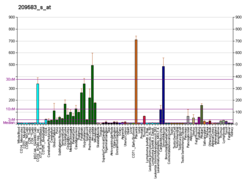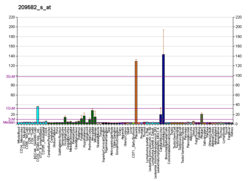CD200
OX-2 membrane glycoprotein,also named CD200 (Cluster of Differentiation200)[5]is a humanproteinencoded by theCD200gene.[6]CD200 gene is in human located on chromosome 3 in proximity to genes encoding other B7 proteinsCD80/CD86.In mice CD200 gene is onchromosome16.[7]
The protein encoded by this gene is a type-1 membrane glycoprotein, which contains two IgSFimmunoglobulindomains, transmembrane region and a 19 amino acid long cytoplasmatic domain.CD 200 belongs to the immunoglobulin superfamily, particularly belongs to theB7 receptor family.[7][6]
Expression
[edit]CD200 is expressed on dendritic cells, activatedB lymphocytes,activatedT lymphocytes,thymocytes,endothelial cells,neuronsandosteoblastprecursors.Moreover CD200 is expressed on various types of humancancercells includinghairy cell leukemia,acute myeloid leukemia,chronic lymphocytic leukemia,malignantmelanoma,multiple myeloma,testicular cancer,renal carcinoma,colon carcinoma andglioblastoma multiforme.[7][8]
Ininnate immunitycells CD200 expression is induced uponTLRsandNLRsactivation.
At the transcriptional level, CD200 expression is regulated by C/EBP-β. It was shown that CD200 expression is induced byIFN-γandTNF-αin aNF-kappaB,STAT1 and IRF-1 dependent manner[7]
Soluble form
[edit]Soluble CD200 (sCD200) is present inserum.It was shown that elevated levels of serum sCD200 are associated with adversetumorprognosis in chronic lymphocytic leukemia, glioblastoma multiforme,ependymomaandmedulloblastoma.Furthermore, sCD200 is associated with the expansion of myeloid-derived suppressor cells in patients with glioblastoma multiforme.[8]
Truncated form
[edit]Truncated CD200 (CD200tr) is a truncated version of CD200 produced byalternative splicingmechanism. CD200tr lacks approximately 30amino acidsin theNH2-terminalsequence. It was shown that CD200tr acts as a competitive inhibitor to the full length CD200.[7]
Function
[edit]CD200 interacts with its receptorCD200Rand leads to immunosuppressive signaling. CD200R is strongly expressed onmacrophages,neutrophilsandmast cellsas well as on some subtypes of B lymphocytes and T lymphocytes. In thetumor microenvironmentCD200R is expressed on tumor-associatedmyeloid cells,particularly in tumor-associate macrophages,myeloid-derived suppressor cells,tumor-associateddendritic cellsand also inregulatory T lymphocytes.[9][8]
CD200-CD200R engagement inhibits T-cell immune response, shiftscytokineprofile towardsTh2 type response,decreasesNK cellcytotoxicactivity, promotes indoleamin-2,3 dioxygenase production in macrophages and triggers regulatory T cell expansion. CD200 on dendritic and lymphoid effector cells modulates the activation threshold of inflammatory response and thus contributes to the maintenance ofself-tolerance.[7][10]Interaction between CD200 and CD200R results in a down-regulation ofbasophilsfunction and inhibits lytic function of NK cells. In IFN-γ and TNF-α producing macrophages, CD200-CD200R interaction leads to inhibition of function through Dok2 and RasGAP dependent mechanism. Elevated expression of CD200R on macrophages is associated with alternative activation of macrophages toM2 phenotype.[7]
Mechanism of action
[edit]The engagement of CD200 to CD200R leads totyrosinephosphorylationon CD200R cytomplasmaticPTB domain.This leads to a recruitment of adaptor proteinsDOK-1andDOK-2that promotes binding ofSHIPto DOK-1 and the recruitment ofRasGAPwhich negatively regulates theMAPK/ERK signaling pathway.This signaling leads to the inhibition ofproinflammatory cytokinerelease and inhibition of immune cell activation and suppression ofmast cell degranulation.[8]
Clinical significance
[edit]Pathogens modulate CD200-CD200R axis
[edit]CD200-encoding gene has been acquired by a number ofvirusesinfecting animals as well as human, for example some humanherpesviruses.
KSHV, also known as human herpesvirus-8 is, essential for the development ofKaposi sarcoma.This virus produces an ortholog of CD200, known as viral OX2 (vOX2), a 55 kDa protein. This gene is expressed on the surface of infected cells during viral replicative state. vOX-2 has an approximately 40% sequence similarity with the human gene for CD200 but shares key residues with CD200 in its binding site for CD200R. Due to its ability to engage CD200R, vOX2 can target host immune cells (T lymphocytes, macrophages, neutrophils, basophils) and inhibit anti-viral activity. Particularly, vOX2 is capable of decreasing production of TNF-α, IFN-γ from macrophages and T lymphocytes and the CD170a-dependent activation of NK cells.
Leishmania amazonensisinduces expression of CD200 in thebone marrowmacrophages a thus inhibits neighboring macrophages expressing CD200R that inhibitsNOproduction during infection. Infection withTaenia crassicepsandTrypanosoma brucei bruceileads to an overexpression of CD200R on M2 macrophages and consequently to the inhibition of innate immunity response.[7]
Rat cytomegalovirus also express CD200 ortholog known as e127 protein interacts with CD200R. e127 protein is expressed on the surface of infected cells.[8]
In cancer
[edit]CD200 is overexpressed in cancer cells in a number of human tumors including melanoma, ovarian cancer, some B-cell malignances and small cell lung carcinoma. In the tumor microenvironment CD200 is also expressed in endothelial cells and activated T lymphocytes, B lymhocytes and myeloid cells. These cells can thus interact with cells expressing CD200R such as T regulatory cells, tumor-associated dendritic cells, tumor associated macrophages and myeloid derived suppressor cells (MDSC). It was shown that CD200 expressed on tumor cells promotes expansion of MDSCs that are capable of inhibiting anti-tumor immune response. CD200 blockade inhibits tumor growth and decreases number of MDSCs in tumor tissue.[7]
The exact relationship between CD200 and cancer development, as well as its impact on disease prognosis, remains unclear and appears to vary depending on the type of tumor.[9]
In transplantation
[edit]It was shown that in animal models CD200 prolongsallograftsurvival. This effect is associated with polarization of cytokine response towards increased production of type-2 cytokines and decreased production of type-1 cytokines. In in vitro experiments, allostimulated cells in the presence of CD200 decreased their cytotoxic function inTGF-βandIL-10dependent mechanism.[7]
As a drug target
[edit]Samalizumab,recombinant humanized monoclonal antibody targeting CD200 was tested in patients with chronic lymphocytic leukemia (CLL) and multiple myeloma as a phase I study. Samalizumab treatments showed a dose-dependent decrease in CD200 expression on CLL cells and decreased frequencies of circulating CD200+ CD4+ T lymphocytes in a majority of CLL patients and in multiple myeloma patients.[10]
See also
[edit]References
[edit]- ^abcGRCh38: Ensembl release 89: ENSG00000091972–Ensembl,May 2017
- ^abcGRCm38: Ensembl release 89: ENSMUSG00000022661–Ensembl,May 2017
- ^"Human PubMed Reference:".National Center for Biotechnology Information, U.S. National Library of Medicine.
- ^"Mouse PubMed Reference:".National Center for Biotechnology Information, U.S. National Library of Medicine.
- ^"P41217 (OX2G_HUMAN)".Uniprot.Retrieved16 May2013.
- ^ab"Entrez Gene: CD200 CD200 molecule".
- ^abcdefghijKotwica-Mojzych K, Jodłowska-Jędrych B, Mojzych M (February 2021)."CD200:CD200R Interactions and Their Importance in Immunoregulation".International Journal of Molecular Sciences.22(4): 1602.doi:10.3390/ijms22041602.PMC7915401.PMID33562512.
- ^abcdeChoe D, Choi D (2023)."Cancel cancer: The immunotherapeutic potential of CD200/CD200R blockade".Frontiers in Oncology.13:1088038.doi:10.3389/fonc.2023.1088038.PMC9900175.PMID36756156.
- ^abLiu JQ, Hu A, Zhu J, Yu J, Talebian F, Bai XF (2020). "CD200-CD200R Pathway in the Regulation of Tumor Immune Microenvironment and Immunotherapy". In Birbrair A (ed.).Tumor Microenvironment.Advances in Experimental Medicine and Biology. Vol. 1223. Cham: Springer International Publishing. pp. 155–165.doi:10.1007/978-3-030-35582-1_8.ISBN978-3-030-35581-4.PMC7339106.PMID32030689.
- ^abMahadevan D, Lanasa MC, Farber C, Pandey M, Whelden M, Faas SJ, et al. (August 2019)."Phase I study of samalizumab in chronic lymphocytic leukemia and multiple myeloma: blockade of the immune checkpoint CD200".Journal for Immunotherapy of Cancer.7(1): 227.doi:10.1186/s40425-019-0710-1.PMC6708181.PMID31443741.
Further reading
[edit]- Gorczynski RM (2002). "Evidence for an immunoregulatory role of OX2 with its counter ligand (OX2L) in the regulation of transplant rejection, fetal loss, autoimmunity and tumor growth".Archivum Immunologiae et Therapiae Experimentalis.49(4): 303–309.PMID11726033.
- Douglas J, Albertson DG, Barclay AN, Davis M, Rabbitts PH (September 1988)."RFLP and mapping of human MOX-1 gene on chromosome 3".Nucleic Acids Research.16(18): 9067.doi:10.1093/nar/16.18.9067.PMC338677.PMID2902568.
- McCaughan GW, Clark MJ, Barclay AN (1987). "Characterization of the human homolog of the rat MRC OX-2 membrane glycoprotein".Immunogenetics.25(5): 329–335.doi:10.1007/BF00404426.PMID3032785.S2CID500342.
- Wright GJ, Puklavec MJ, Willis AC, Hoek RM, Sedgwick JD, Brown MH, Barclay AN (August 2000)."Lymphoid/neuronal cell surface OX2 glycoprotein recognizes a novel receptor on macrophages implicated in the control of their function".Immunity.13(2): 233–242.doi:10.1016/S1074-7613(00)00023-6.PMID10981966.
- Hoek RM, Ruuls SR, Murphy CA, Wright GJ, Goddard R, Zurawski SM, et al. (December 2000). "Down-regulation of the macrophage lineage through interaction with OX2 (CD200)".Science.290(5497): 1768–1771.Bibcode:2000Sci...290.1768H.doi:10.1126/science.290.5497.1768.PMID11099416.
- Wright GJ, Jones M, Puklavec MJ, Brown MH, Barclay AN (February 2001)."The unusual distribution of the neuronal/lymphoid cell surface CD200 (OX2) glycoprotein is conserved in humans".Immunology.102(2): 173–179.doi:10.1046/j.1365-2567.2001.01163.x.PMC1783166.PMID11260322.
- Wright GJ, Cherwinski H, Foster-Cuevas M, Brooke G, Puklavec MJ, Bigler M, et al. (September 2003)."Characterization of the CD200 receptor family in mice and humans and their interactions with CD200".Journal of Immunology.171(6): 3034–3046.doi:10.4049/jimmunol.171.6.3034.PMID12960329.
- Chen DX, Gorczynski RM (February 2005). "Discrete monoclonal antibodies define functionally important epitopes in the CD200 molecule responsible for immunosuppression function".Transplantation.79(3): 282–288.doi:10.1097/01.TP.0000149506.61000.86.PMID15699757.S2CID19242441.
- Chen Z, Marsden PA, Gorczynski RM (February 2006). "Cloning and characterization of the human CD200 promoter region".Molecular Immunology.43(6): 579–587.doi:10.1016/j.molimm.2005.04.014.hdl:1807/16344.PMID15955564.
- Shiratori I, Yamaguchi M, Suzukawa M, Yamamoto K, Lanier LL, Saito T, Arase H (October 2005)."Down-regulation of basophil function by human CD200 and human herpesvirus-8 CD200".Journal of Immunology.175(7): 4441–4449.doi:10.4049/jimmunol.175.7.4441.PMID16177086.
- Kimura K, Wakamatsu A, Suzuki Y, Ota T, Nishikawa T, Yamashita R, et al. (January 2006)."Diversification of transcriptional modulation: large-scale identification and characterization of putative alternative promoters of human genes".Genome Research.16(1): 55–65.doi:10.1101/gr.4039406.PMC1356129.PMID16344560.
- Matsue H (December 2005)."CD 200-mediated regulation of skin immunity".The Journal of Investigative Dermatology.125(6): x–xi.doi:10.1111/j.0022-202X.2005.23978.x.PMID16354172.
External links
[edit]- CD200+Antigenat the U.S. National Library of MedicineMedical Subject Headings(MeSH)
- HumanCD200genome location andCD200gene details page in theUCSC Genome Browser.
- Overview of all the structural information available in thePDBforUniProt:O54901(Mouse OX-2 membrane glycoprotein (CD200)) at thePDBe-KB.
This article incorporates text from theUnited States National Library of Medicine,which is in thepublic domain.







